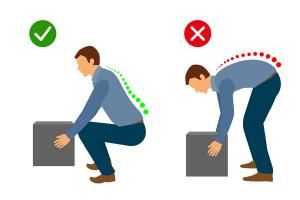Jokes about nagging back pain get standup comedians a lot of laughs, but back strains and sprains are not at all funny, nor should they be an unavoidable curse to anyone.
Back injuries suffered in California’s workplaces last year ran up a bill of millions of dollars. Those disabling back injuries were no laughing matter for the workers who lost time from work or from their personal activities. The sad truth is that most of the pain and lost time could have been prevented if workers had been more aware of how their backs function and how to safely lift bulky or heavy loads.
The back is a network of fragile ligaments, discs, and muscles which can easily be thrown out of order. The back’s complex design breaks down when it is forced to perform activities it was not designed to do.
One sure way to risk injuring the back is to lift heavy or bulky loads improperly or unassisted. The unsupported back cannot operate like a derrick or a crane boom. Lifting with the back twisted or bent just begs for a pulled muscle or ruptured disc. The back can be damaged quickly but can take a long time to heal. So, workers should be encouraged to do their lifting with good sense and a little extra help from a co-worker or mechanical aid.
Workers should learn to squat over the item to be lifted and face it squarely. In this position, the back gets added lifting strength and power from the legs and arms. Teach workers to tilt the item on edge with its long axis straight up so the center of the weight is as high as possible above the ground. Next, the worker should move up close to the item, because the backbone must act as a supporting column, and it takes the least strain close in. In this position, the worker is ready to lift. Still squatting, the feet should be set with legs pointed right at the load, with the back straightened, the worker may then grasp the load with both arms and slowly stand up with it.
A good way to help workers learn the right from the wrong way to lift, is to have them practice lifting correctly a few times. They will notice that the correct way to lift is the easiest way to lift the load, with the least strain and awkwardness. To lift the wrong way will, over time, cause injury and pain and then no one will be laughing.

